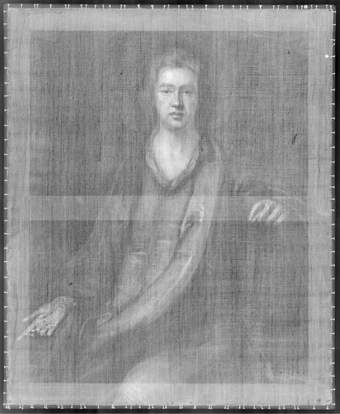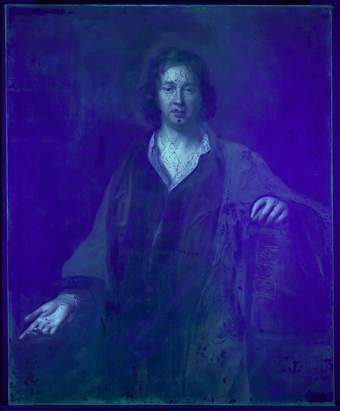
Fig.1
Mary Beale 1633–1699
Charles Beale
c.1680–5
Oil paint on canvas
1268 x 1029 mm
T15197

Fig.2
X-radiograph of Charles Beale
The painting (fig.1) is on a very heavy-weight canvas with a pronounced twill weave pattern, whose threads are of uneven thickness (fig.2). The canvas has been glue-paste lined onto a medium-weight, plain weave canvas of much lighter weight than the original canvas, and the stretcher appears not to be original.1 The canvas tacking margin was removed at the top edge, and therefore probably at all edges, during the lining process.
The ground layer is covered by the paint except at a few losses in the background, and it appears to have a light or mid warm tone.

Fig.3
Charles Beale in raking light from the left

Fig.4
Charles Beale in ultraviolet light
The paint was relatively thinly applied everywhere, most notably for the hair and the background (fig.3). The costume is thinly painted, and the face and the depicted gilding for the book title lack impasto. This has allowed the weave texture to remain prominent, throughout, even in the thicker paint of the highlight on the forehead. Opaque scumbles can be seen throughout the background and wet-in-wet mixing and soft blending are particularly visible in the face and in the silk outer garment. The paint is generally opaque and of a well-bound consistency, and glazing appears quite minimal. Throughout the waistcoat, a pinkish-red underpaint can be glimpsed through the slightly worn upper paint layer. Examination in ultraviolet light (fig.4) indicates that the floral pattern in the outer garment has been applied over an isolating layer of natural resin varnish that may have been applied locally to enhance the lustre of the silk.
Prior to its arrival at Tate, the surface had undergone varnish removal. There are several restored damages that appear to have been holes or tears to the canvas present prior to the lining. In ultraviolet light, discrete retouching (rather than overpainting) can be seen across the entire painted surface (fig.4). There are many small, skillfully executed retouchings in the face and hands, which reduce the visibility of worn paint and dirt-filled cracks. Areas of retouching in the background and clothing are larger and at points were more broadly applied, particularly along the left edge and in the lower left section of clothing. Some areas of retouching in the brown background are slightly mismatched, which suggested more than one restoration has taken place. Clusters of very small unrestored paint and ground losses are visible in the background.
A varnish layer is present overall, consisting of residual historic natural resin varnishes and a recent overall modern synthetic resin varnish. Old varnish and dirt residues appear present in weave interstices and ultraviolet light reveals that old varnish layers have been both selectively removed from the light passages and unevenly thinned across the background.

Fig.5
Charles Beale in the frame in which it was acquired
The painting is fitted into a carved, gessoed and gilded frame (fig.5) which appears not to be original, and which has been cut down at both top corners.
March 2022
